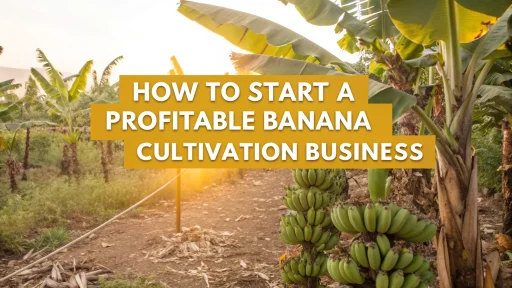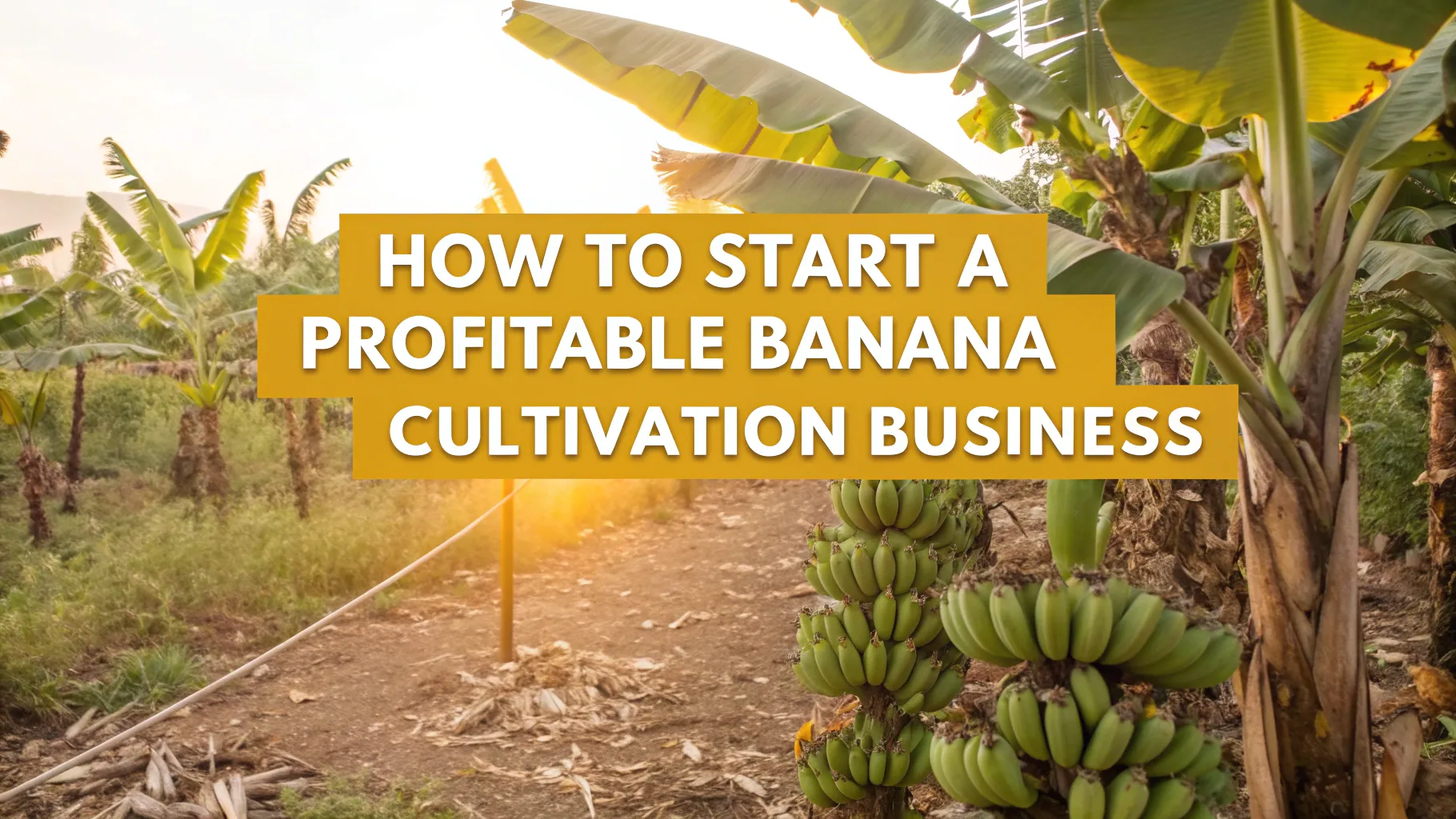Banana farming is a unique agribusiness. Bananas are one of the most popular fruits in the world, both fresh and processed. Banana cultivation business offers stable revenue and growth opportunities for startups and entrepreneurs venturing into the agribusiness manufacturing industry. This guide will take you from understanding the changing market landscape to implementing the best-in-class agronomic practices. It will also equip you with the tools to launch and scale up a profitable banana business.
Understanding Market Dynamics
Bananas are unique among fruits. Bananas are a staple in many tropical and semi-tropical areas, while they’re also a favorite snack or ingredient in the developed world. The global banana market is expected to reach USD 148 billion by 2030. This is up from USD138 billion in 2023. It is also projected to grow at a compounded annual rate of approximately 0.8% through 2030. This growth is a result of both the rising incomes per capita in emerging markets and the diverse applications for banana by-products. These range from banana flour in gluten-free baked goods to nutraceutical products derived from banana skins.
Asia-Pacific is the largest region in terms of production and consumption. It accounts for over 55 percent. India contributes more than 30 percent of the global tonnage thanks to favorable climate conditions and a large number of smallholder farmers. China, Bangladesh and the Philippines are also producing, while Vietnam, Thailand and other Asian countries have increased exports to North America, Europe and Australia by investing in modern cold chain facilities. Latin American countries like Ecuador and Costa Rica continue to be the leading exporters. They use advanced logistics networks to ship their products to Western markets.
The Middle East and Africa are the fastest-growing regional markets. Despite their smaller absolute volumes, they have seen annual consumption growth of 3-4 percent. The demand for these products is being driven by improved transport infrastructure, urbanization and a growing awareness of health among consumers. Entrepreneurs who tap these emerging demand centres–either by direct exports or by establishing local production units–can benefit from increased price realizations and decreased competition.
Related: Banana Products Manufacturing Business Ideas
Why entrepreneurs should consider banana cultivation
Banana cultivation offers several advantages to startups looking to enter the agricultural manufacturing industry. Bananas are perennial crops: once established, healthy plantations can produce marketable fruit for up to five years without the need for replanting. It is a contrast to seasonal crops, which require recurrent investments in land and labor. The crop’s wide suitability makes it possible to plant on small parcels of land, between one and five hectares. This allows for capital structures in micro and small enterprises. Third, the variety of downstream processing options increases revenue diversification. Sales of fresh fruit can be complemented with added-value lines, such as banana powders, banana purees, banana chips and organic fertilizer made from waste biomass.
Banana farming can benefit from research that has been done on pest-resistant, high-yielding cultivars and disease management. Many banana-producing nations assist with agricultural extension, subsidised planting materials, and subsidized loans for cold-chain gear. These factors, when combined, create an environment where new entrants are able to quickly adopt proven agronomic protocol and access multiple revenue sources without the large-scale investment required for industrial manufacturing lines.
Detailed Cultivation Method
Site Selection and Soil Preparation
The right location for the cultivation of bananas is crucial. Bananas grow best in soils that are well-drained and loamy, with a high organic content. The ideal fields are on gently sloped or flat ground. This will prevent waterlogging and root rot. The pH of the soil should be between 5.5-7.0. Conduct a soil test before planting to identify nutrient deficiencies. The uniformity of planting depth is ensured by plowing the soil to a depth between 30-45 cm, followed by leveling. Compost or farmyard manure that has been well decomposed can be added to the soil in amounts of 15-20 tons per hectare. This will improve moisture retention, enrich the soil structure and boost microbial activity.
Selecting Varieties for Planting
The right banana variety can influence yield, disease resistance and market acceptance. Cavendish varieties (like ‘Grand Nain,’ which have a uniform bunch size and a relatively long shelf-life) dominate the global banana trade because of their resilience to handling and uniform bunch sizes. For domestic markets, however, locally adapted types like ‘Robusta’ or plantains may command premium prices and meet consumer preferences. The use of disease-free tissue-cultured plantlets, or healthy suckers as air layers, is a viable method for propagation. Although tissue culture plantlets are more expensive upfront, they eliminate soil-borne diseases and guarantee crop uniformity. They can yield up to 40 tons of grain per hectare on well-managed farms.
Planting Techniques and Density
The spacing between banana plants should be approximately 2.5 meters wide by 2.5 meters high, allowing for 1,600 plants to be planted per hectare. Two to three weeks before planting, 60 x60 x60 centimeters-sized holes are dug and filled with topsoil and compost mixed with a base dose of balanced fertiliser. The corm base should be level with the surface of the soil to prevent stem flaring. This will also promote healthy rooting. To ensure good establishment, young plants need immediate irrigation following planting.
Nutrient and Water Management
Balanced nutrition is essential for high growth and yields. Nitrogen, phosphorus, and potassium are applied in ratios that are tailored to the soil test. This is usually around 250 kg of N, 150 kg of P2O5, 500 kg of K2O per hectare, per year, delivered in split doses in accordance with phenological phases. Magnesium and zinc supplements can help prevent common deficiencies, such as reduced fruit size and leaf chlorosis. Mulching with organic material such as cocoa shell or straw not only suppresses the weeds but also conserves moisture.
Bananas require a lot of water: 600-800mm per year. When properly designed, drip irrigation systems with pressure regulators, filtration units and other components can maximize water efficiency, reduce diseases associated with overhead watering and improve nutrient absorption through fertigated injectors.
Pest and Disease Control: Practices
Plantations of bananas are at risk from nematodes and fungal diseases, such as Fusarium Wilt (Panama Disease) and Black Sigatoka. IPM strategies include using pathogen-free plant material, rotating crops with legumes where possible to break the disease cycle, and applying biocontrols like Trichoderma Harzianum or Pseudomonas Fluorescens to suppress soil pathogens. Rotating products with different modes can help delay the development of resistance when fungicides are needed. Inoculum levels can be reduced by removing infected parts of plants and disposing of them safely.
Related: Profitable Banana Powder Manufacturing Business
Harvesting, Post-Harvest Handling
The bananas are harvested when they reach the mature-green stage. This can be 8-10 months following planting, depending on the climate and variety. To avoid bruises, workers must handle the bananas with care. They cut the whole bunch and gently lower it to the ground or into padded tubs. Subsequent operations, including handling, washing, sorting by size and quality, and waxing, are conducted in dedicated packing sheds. The cold-chain (13-14 degrees Celsius with 90-95 per cent relative humidity) is maintained from the field to the buyer. This preserves quality and shelf life.
Processors and Value-Added Opportunities
Banana by-products are a lucrative alternative to the fresh fruit market. A small-scale processing plant near the farm can minimize transport losses. Dehydrated banana chips, for example, require a slicer and a vacuum fryer, a hot-air dryer, as well as a packaging machine. When produced in stainless steel, banana puree marketed to food processing industries commands higher margins. Banana flour, made from green bananas, is a gluten-free, high-value ingredient that taps into the health food trend. Moreover, each processing stream has different buyers from snack manufacturers to baking companies to nutraceutical companies allowing you to hedge price volatility.
Scaling up: From farm to export hub
As your business grows, therefore, investing in pre-cooling and refrigerated transportation can help you transition from selling locally to supermarket chains in the US and abroad. Quality certifications such as GlobalG.A.P., HACCP, or organic accreditation unlock premium price segments and foster buyer confidence. Cooperatives and producer companies are a great way to aggregate the produce of multiple smallholders. This can lead to export volumes, as well as negotiating power, that individual growers simply cannot match.
Sustainability and Risk Management
Climate variability is a major risk for banana farmers. Windbreaks such as eucalyptus and bamboo can help protect banana plantations against cyclonic winds, which are common in tropical areas. Cover crops and intercropping legumes with cover crops maintain soil health and reduce erosion. Organic waste from pruning and packing–pseudostems, leaves, rejected fruit–can be composted or directed to biogas digesters, creating renewable energy and reducing greenhouse gas emissions. Circular approaches improve the environmental performance of brands and also increase their reputation with eco-conscious consumers.
Market Outlook and Growth Projections
The steady expansion of the global banana market is largely due to the growing middle class in South and Southeast Asia. This population has a more varied diet, which includes more fruit. The developed markets will continue to demand specialty bananas and organic certified bananas. This will support the development of niche segments. Meanwhile, research into disease-resistant varieties and precision-agriculture tools–such as drone-based nutrient mapping–promises to boost yields and cut input costs. Entrepreneurs who integrate digital monitoring and data-driven decisions can gain efficiency and secure competitive advantages.
For more information, check out this video
How NPCS Supports Entrepreneurs in the Banana Cultivation Business
Niir Project Consultancy Services is a company that specializes in preparing detailed techno-economic feasibility reports for agribusinesses. This includes banana cultivation Business. The reports are customizable and cover all aspects of the business, from raw material sourcing and optimized manufacturing processes to financial projections and plant layout designs. NPCS partners with entrepreneurs to rigorously evaluate the feasibility of setting up new banana farms and processing units. This reduces risk and accelerates time to market.
Which business to start? How to choose a business idea?
Conclusion
Banana Cultivation business offers the benefits of a reliable cash crop and a variety of downstream processing options. Entrepreneurs can build profitable and resilient agribusinesses by understanding the dynamics of the market, selecting disease-resistant varieties, implementing integrated water and nutrient management systems, and pursuing a strategic value-addition. Integrating sustainability measures and exploring advanced technology will enhance long-term viability. You can navigate the entire venture with confidence, from initial feasibility studies to full-scale production.







